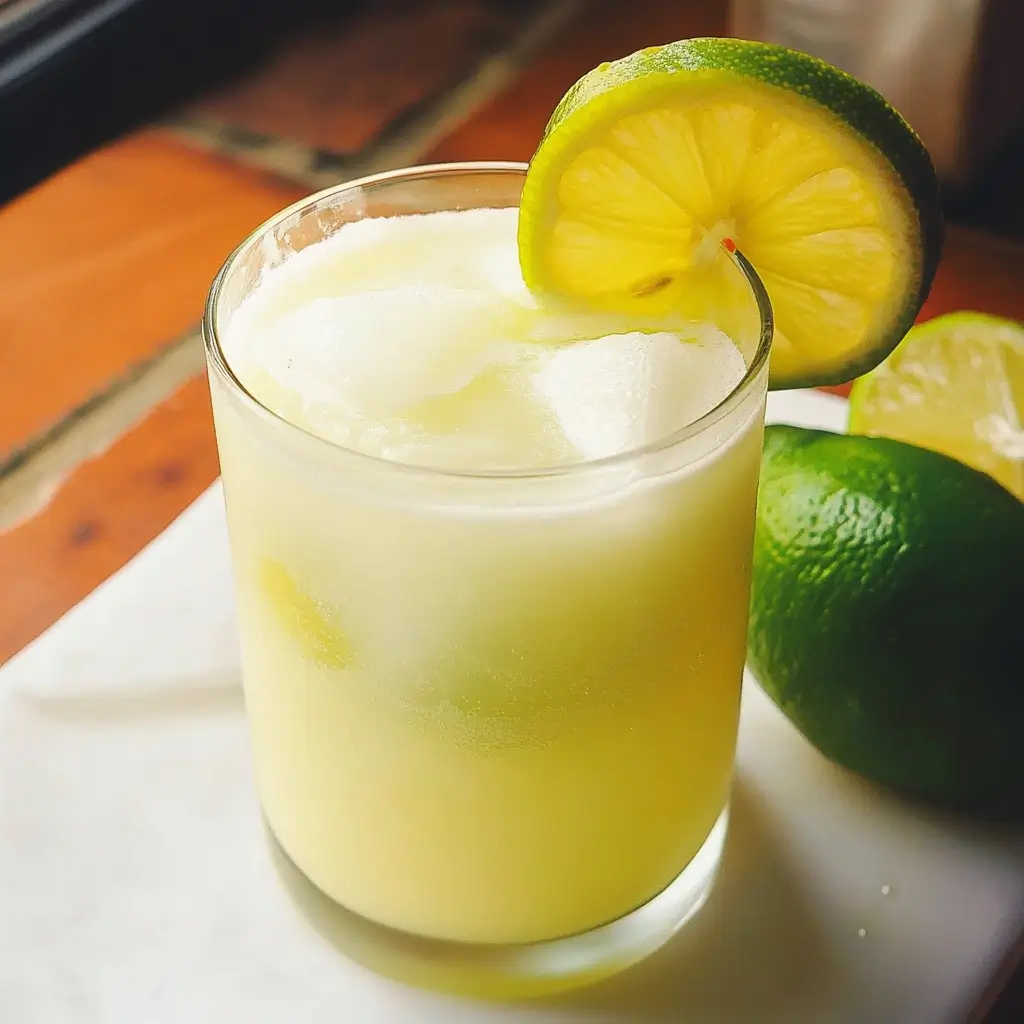The first time I stumbled upon the magic that is Brazilian Lemonade, or “Limonada Suíça” as it’s affectionately known in its homeland, was at a friend’s summer barbecue. I was expecting the usual tart, clear lemonade, but what I got was a revelation. It was creamy, frothy, intensely lime-flavored yet beautifully balanced, with a sweetness that was satisfying but not cloying. My kids, usually picky, were instantly hooked, clamoring for refills. It became an instant family favorite, a go-to for hot days, gatherings, or just when we need a special, refreshing treat. The secret, I learned, was the surprising inclusion of sweetened condensed milk and, crucially, using the whole limes – peel and all! This recipe isn’t just a drink; it’s an experience, a vibrant taste of Brazilian sunshine that’s incredibly easy to whip up. Prepare to be amazed by how simple ingredients can transform into something so uniquely delicious.
What is Brazilian Lemonade? (A Deeper Dive into Limonada Suíça)
Brazilian Lemonade, often called “Limonada Suíça” (Swiss Lemonade) in Brazil, is a unique and incredibly refreshing beverage that stands apart from traditional lemonades. The most striking difference is its creamy texture and opaque, milky appearance, a result of blending whole limes (peel and all, though sometimes just the flesh and juice) with water, sugar, and the star ingredient: sweetened condensed milk.
The name “Limonada Suíça” is a bit of a charming misnomer, as its origins are firmly Brazilian, not Swiss. One popular theory suggests the name might have come from the condensed milk brand, often Nestlé, which has Swiss origins, being a key ingredient. Another theory points to the creamy, rich quality resembling some Swiss dairy products or drinks. Regardless of the etymological mystery, this drink is a beloved staple in Brazil, enjoyed in homes, at beachside kiosks (barracas), and in restaurants.
Unlike American lemonade, which typically uses only lemon juice, Brazilian Lemonade utilizes the entire lime (minus the very ends and sometimes the white pith, depending on preference and lime variety). This method extracts oils from the lime zest, contributing to a more intense, complex, and aromatic lime flavor. The condensed milk not only adds sweetness but also emulsifies the mixture, creating a smooth, frothy, and almost milkshake-like consistency, while beautifully tempering the tartness of the limes. It’s a delightful balance of tart, sweet, and creamy – a truly tropical sensation.
Why You’ll Fall in Love with This Brazilian Lemonade Recipe
There are countless reasons why this Brazilian Lemonade recipe will quickly become a fixture in your beverage rotation. Here’s why it’s so captivating:
- Uniquely Delicious Flavor: The combination of zesty lime (amplified by using the whole fruit) and creamy, sweet condensed milk is unlike anything you’ve probably tasted. It’s a complex flavor profile that is simultaneously refreshing, tangy, sweet, and rich.
- Incredibly Refreshing: On a hot day, nothing quite hits the spot like this chilled, frothy drink. The vibrant lime cuts through the heat, while the creamy texture makes it feel more substantial and satisfying than plain juice.
- Surprisingly Easy to Make: Despite its gourmet taste and appearance, Brazilian Lemonade is remarkably simple and quick to prepare. With just a few basic ingredients and a blender, you can whip up a batch in minutes.
- Crowd-Pleaser: Whether it’s for a family gathering, a kids’ party, or a summer barbecue, this drink is consistently a hit. Its novelty and deliciousness appeal to both adults and children.
- Visually Appealing: The creamy, pale green or milky white hue, often topped with a light froth, makes it an attractive beverage to serve. Garnished with a lime wheel or mint sprig, it looks as good as it tastes.
- Customizable: You can easily adjust the sweetness, tartness, and creaminess to your liking. Want it tarter? Add more lime or less sugar. Prefer it less sweet? Reduce the sugar or condensed milk.
- A Taste of the Tropics: This drink instantly transports you to a sunny Brazilian beach. It’s an accessible way to enjoy a bit of exotic flavor in your own home.
- Conversation Starter: Be prepared for guests to ask, “What is this amazing drink?” It’s a fun recipe to share and introduce to friends and family who haven’t experienced it before.
The magic lies in its perfect balance and the unexpected joy of that creamy, lime-kissed goodness.
Unveiling the Magic: Brazilian Lemonade Ingredients
The beauty of Brazilian Lemonade lies in its simplicity, requiring just a handful of readily available ingredients to create something truly special. Here’s what you’ll need:
- Limes: 4 medium-sized, juicy limes (preferably thin-skinned varieties like Persian or Tahiti limes)
- Sweetened Condensed Milk: 1/4 cup (60ml), or to taste (this is the key to its creaminess!)
- Granulated Sugar: 1/2 cup (100g), or to taste (adjust based on your limes’ tartness and personal preference)
- Cold Water: 4 cups (approximately 1 liter)
- Ice Cubes: Plenty for blending and serving
Let’s break down the role of each component:
H3: Limes: The Zesty Heart
The soul of Brazilian Lemonade is, of course, the lime. For the best flavor, choose fresh, ripe limes that are heavy for their size, indicating juiciness. Thin-skinned varieties are often preferred as they tend to have less bitter white pith. You’ll be using most of the lime, including the peel, which imparts essential oils and a robust lime aroma. Ensure they are well-washed before use.
H3: Sweetened Condensed Milk: The Creamy Soul
This is the secret weapon! Sweetened condensed milk is what transforms this from a simple limeade into the rich, creamy, and frothy “Limonada Suíça.” It adds sweetness, a luxurious mouthfeel, and helps to mellow the tartness of the limes, creating a beautifully balanced beverage. Don’t be tempted to skip it or substitute it with regular milk if you want the authentic experience.
H3: Sugar: The Sweet Balancer
While the condensed milk provides some sweetness, additional granulated sugar is typically needed to achieve the perfect sweet-tart equilibrium. The amount can be adjusted based on how tart your limes are and your personal sweetness preference. You can start with a smaller amount and add more if needed. Some people also like to use sugar alternatives, but classic Brazilian Lemonade uses regular sugar.
H3: Water & Ice: The Refreshing Body
Cold water forms the base of the lemonade, diluting the concentrated flavors to a drinkable consistency. Ice is crucial for two reasons: first, a small amount can be blended with the other ingredients to make the drink extra frothy and chilled from the get-go. Second, you’ll want plenty of ice for serving to keep it perfectly cold and refreshing.
Crafting Perfection: Step-by-Step Brazilian Lemonade Instructions
Making authentic Brazilian Lemonade is a quick and straightforward process. Follow these steps for a perfectly creamy and refreshing drink every time:
- Prepare the Limes:
- Wash the limes thoroughly under running water.
- Cut off the very ends (the top and bottom nubs) of each lime, as these parts can be a bit tough or dry.
- Cut each lime into eighths (quarters, then halve each quarter). Some people prefer to remove the central white pith/core at this stage if their limes are particularly pithy, as this can contribute to bitterness. However, for many common lime varieties, this step isn’t strictly necessary if you blend briefly.
- First Blend (Extracting Lime Flavor):
- Place the lime pieces and 2 cups of the cold water into a blender.
- Pulse the blender 5-7 times for just a few seconds each time. You want to break up the limes and release their juice and oils, but do not over-blend. Over-blending, especially the peel and pith, can make the lemonade bitter. The water should look cloudy and fragrant.
- Strain the Lime Mixture:
- Pour the blended lime mixture through a fine-mesh sieve or strainer into a pitcher or large bowl.
- Press down gently on the solids with the back of a spoon to extract as much liquid as possible. Discard the pulp and peel left in the strainer. This step is crucial for a smooth lemonade without bits of peel.
- Second Blend (Adding Creaminess & Sweetness):
- Rinse the blender container to remove any lingering solids (optional, but helps ensure smoothness).
- Pour the strained lime liquid back into the clean blender.
- Add the granulated sugar, sweetened condensed milk, and the remaining 2 cups of cold water.
- Add about 1 cup of ice cubes to the blender. This will help make the drink extra frothy and chilled.
- Blend again for about 20-30 seconds, or until everything is well combined, the sugar is dissolved, and the lemonade is frothy and creamy.
- Taste and Adjust:
- Give your Brazilian Lemonade a taste. If it’s too tart, you can blend in a little more sugar or condensed milk. If it’s too sweet for your liking (unlikely with these proportions, but possible), you can add a tiny splash more water or a squeeze of extra lime juice (from a separate lime, strained).
- Serve Immediately:
- Fill glasses with plenty of fresh ice cubes.
- Pour the Brazilian Lemonade over the ice.
- Garnish with a lime slice or wheel, or a sprig of mint, if desired.
Enjoy your delicious, homemade Brazilian Lemonade right away for the best flavor and frothy texture!
Nutritional Snapshot (Estimated)
Please note that these nutritional values are approximate and can vary based on the exact size of the limes, the specific brand of condensed milk, and the precise amount of sugar used.
- Servings: This recipe makes approximately 4-6 servings.
- Calories per serving (estimated for 5 servings): Approximately 150-200 calories.
Breakdown (Approximate):
- Total Calories for Recipe: Around 750-1000 calories.
- Limes: ~80-100 calories (for 4 medium limes)
- Sugar (1/2 cup): ~385 calories
- Sweetened Condensed Milk (1/4 cup): ~260 calories
- Key Contributors to Calories: Sugar and sweetened condensed milk are the primary sources of calories.
- Fat: Primarily from the condensed milk, but relatively low per serving.
- Carbohydrates: Mainly from sugar and condensed milk.
- Protein: Minimal, from condensed milk.
- Vitamin C: Good source from the limes.
For a more precise nutritional calculation, you would need to use a nutritional calculator and input the exact quantities and brands of ingredients used. To reduce calories, you can experiment with reducing the amount of sugar and/or condensed milk, but this will alter the classic taste and texture.
Quick & Easy: Preparation Time
Brazilian Lemonade is celebrated not just for its unique taste but also for its incredibly quick preparation.
- Preparation Time (Chopping Limes, Measuring): 5 minutes
- Blending Time (Two Stages): 1-2 minutes
- Straining Time: 2-3 minutes
- Total Time: Approximately 10 minutes
This makes it an ideal drink for spontaneous cravings, unexpected guests, or when you simply want a delicious, refreshing beverage without a lot of fuss. The speed and ease of this recipe are definite highlights!
Serving Your Sensational Brazilian Lemonade
Serving Brazilian Lemonade is all about enhancing its refreshing and visually appealing qualities. It’s best served immediately after blending to enjoy its optimal frothiness and chill.
H3: Classic Presentation
- Glasses: Serve in tall glasses (like Collins or highball glasses) to showcase its creamy color and allow plenty of room for ice. Mason jars also offer a rustic, appealing look.
- Ice, Ice, Baby: Always fill the glasses generously with ice cubes before pouring the lemonade. This ensures it stays perfectly chilled.
H3: Garnishing Touches
While delicious on its own, a simple garnish can elevate the presentation:
- Lime Wheels or Slices: A thin slice or wheel of lime perched on the rim of the glass or floating in the drink is a classic and fitting garnish.
- Lime Zest: A little finely grated lime zest sprinkled on top can add an extra burst of lime aroma.
- Mint Sprigs: A fresh sprig of mint adds a lovely touch of green and a subtle aromatic hint that complements the lime beautifully.
- Edible Flowers: For a more festive or elegant occasion, a few small edible flowers can make the drink look stunning.
- Sugared Rim (Optional): For an extra touch of sweetness and fancy presentation, you can sugar the rim of the glasses. To do this, run a lime wedge around the rim of each glass, then dip the rim into a shallow plate of granulated sugar.
H3: Perfect Occasions
Brazilian Lemonade is versatile and suits many occasions:
- Summer Barbecues & Cookouts: It’s the ultimate thirst-quencher for outdoor gatherings.
- Poolside or Beach Days: Its tropical vibe makes it a perfect companion for sun-soaked relaxation.
- Family Dinners: A delightful non-alcoholic option that everyone, from kids to adults, will enjoy.
- Parties & Celebrations: Its unique flavor and creamy texture make it a memorable party drink.
- Brunches: A refreshing alternative to mimosas or orange juice.
- A Simple Afternoon Treat: Perfect for when you just need a pick-me-up.
H3: Food Pairings
The sweet, tart, and creamy nature of Brazilian Lemonade pairs well with a variety of foods:
- Spicy Dishes: The creaminess and sweetness help to cool the palate, making it excellent with spicy Brazilian, Mexican, or Thai food.
- Grilled Meats & Vegetables: Complements the smoky flavors of barbecue beautifully.
- Light Salads & Sandwiches: A refreshing counterpoint to lighter lunch fare.
- Salty Snacks: The sweet and tart notes balance well with salty appetizers like chips and salsa, or Brazilian Pão de Queijo (cheese bread).
- Desserts: While sweet itself, it can be a nice accompaniment to less sweet, fruit-based desserts.
Remember, the key is to serve it icy cold and enjoy that delightful froth right away!
Pro Tips for the Ultimate Brazilian Lemonade Experience
To ensure your Brazilian Lemonade is consistently spectacular, keep these five pro tips in mind:
- Don’t Over-Blend the Limes: This is the golden rule. When blending the limes with water in the first step, use short, sharp pulses. You’re aiming to break them up and release their juices and essential oils from the peel, not pulverize them into a smooth puree. Over-blending, especially the white pith and seeds, will extract bitter compounds and can ruin your lemonade. A few quick pulses (5-7 times, 1-2 seconds each) are usually sufficient.
- Strain Meticulously: After the initial blend, thorough straining is crucial. Use a fine-mesh sieve to remove all bits of lime peel, pith, and seeds. Press gently on the solids to extract all the flavorful liquid, but don’t force too much of the bitter pulp through. A double strain (pouring through the sieve twice or using a sieve lined with cheesecloth for an ultra-smooth result) can make a difference if you’re particular about texture.
- Adjust Sweetness and Creaminess to Taste: The provided recipe is a great starting point, but personal preferences vary. Taste the lemonade after the final blend (before pouring over a full glass of ice). If it’s too tart, add a bit more sugar or condensed milk and blend briefly. If you prefer it less sweet or less creamy, you can slightly reduce the condensed milk or sugar next time, or add a splash more water.
- Use Cold Ingredients & Serve Immediately: For the best taste and texture, start with cold water. Adding ice to the blender in the second blending stage helps make it extra frothy and chilled. Brazilian Lemonade is at its peak right after it’s made, when it’s frothy and ice-cold. It tends to separate if left sitting for too long, and the froth will subside.
- Choose Quality Limes: The better your limes, the better your lemonade. Look for limes that are bright green (or yellowish-green for some varieties), feel heavy for their size (indicating good juice content), and have relatively thin skins. Wash them well before using. Persian or Tahiti limes are commonly used and work very well. Avoid limes that are hard, dull, or have very thick, tough skins.
By following these tips, you’ll master the art of making truly exceptional Brazilian Lemonade every single time!
Brazilian Lemonade FAQs: Your Questions Answered
Here are answers to some frequently asked questions about making and enjoying Brazilian Lemonade:
- Q: Why is it called “Swiss Lemonade” (Limonada Suíça) if it’s Brazilian?
- A: This is a common point of curiosity! The exact origin of the name “Limonada Suíça” isn’t definitively known, but there are a couple of popular theories. One suggests it’s because a key ingredient, sweetened condensed milk, was often from Swiss brands like Nestlé when the drink gained popularity in Brazil. Another theory posits that the creamy, rich quality reminded people of certain Swiss dairy products or beverages. Despite the name, its creation and popularity are firmly rooted in Brazilian culinary culture.
- Q: Will using the whole lime, including the peel, make the lemonade bitter?
- A: It can, if not done correctly. The key is to blend the limes very briefly (just a few short pulses) and then strain the mixture thoroughly. The peel contains essential oils that contribute a wonderful, intense lime aroma and flavor. However, the white pith underneath the green zest can be bitter. By limiting the blending time, you extract the good flavors without over-extracting the bitterness. Some people also trim away more of the white pith from the lime segments before blending, especially if using limes with thicker pith.
- Q: Can I make Brazilian Lemonade ahead of time?
- A: While you can, it’s strongly recommended to serve Brazilian Lemonade immediately after making it. This is when its frothy texture and vibrant flavor are at their best. If left to sit, it can start to separate (the lime solids from the water and milk), and the froth will dissipate. The flavor can also become slightly more bitter over time as the lime components continue to infuse. If you must make it slightly ahead, store it in an airtight container in the refrigerator and stir or shake well before serving, but expect some loss of frothiness.
- Q: Can I make a vegan version of Brazilian Lemonade?
- A: Yes, you can! The traditional creaminess comes from dairy-based sweetened condensed milk. To make a vegan version, substitute the regular sweetened condensed milk with a vegan alternative, such as sweetened condensed coconut milk or sweetened condensed oat milk. These are becoming more widely available. The flavor profile might be slightly different (e.g., a subtle coconut note if using condensed coconut milk), but you’ll still achieve a deliciously creamy and refreshing beverage. Adjust sugar as needed, as vegan condensed milks can vary in sweetness.
- Q: How can I adjust the recipe if I prefer it less sweet or more tart?
- A: This recipe is very forgiving and easy to customize.
- For less sweetness: Start by reducing the amount of granulated sugar. You can also slightly reduce the amount of sweetened condensed milk, but keep in mind this will also reduce some of the creaminess.
- For more tartness: You can add the juice of an extra half or whole lime (strained) to the final mixture. Alternatively, simply reduce the sugar.
- For more creaminess (and sweetness): Add a little more sweetened condensed milk.
Always taste and adjust after blending, before serving over a full glass of ice.
- A: This recipe is very forgiving and easy to customize.





